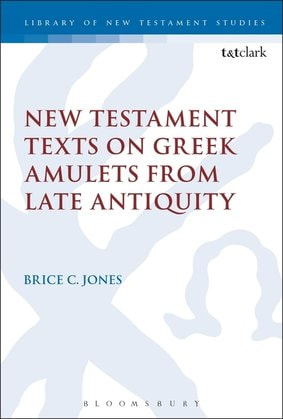|
P.Oxy. VIII 1151 is an elaborate Christian amulet, designed to ward off evil and sickness. It was found “tightly folded, and tied with a string” (ed. princ., 251). It is no. 21 in de Bruyn and Dijkstra’s checklist (BASP 48, 2011) under Table 1 (“Certain Amulets and Formularies”). See the transcription here. The amulet is historically significant for a number of reasons: the reference to “intercession of our lady [=Mary] the theotokos,” a list of saints, prosopography (the papyrus mentions Anastasia, Euphemia, Joannia), reference to John as θεόλογος, and a citation of John 1:1-3. The designation of Mary as θεοτόκος occurs also in P.Köln VIII 340, another amulet quoting John 1:1-11. P.Oxy. VIII 1151 closes awkwardly with an infinitive in ll. 38-39, which prompted the editor to treat it (rightly) as an imperative. The editor does not mention that it is of course possible that εὔχεσθε is the intended reading, since αι and ε often are merged in the papyri.[1] The phrase εὔχεσθαι πρεσβίαις τῆς δεσποίνης ἡμῶν was subsequently translated for the PGM by Karl Preisendanz (see PGM 5b) as “pray for the intercession of our lady,” thereby understanding differently to whom the prayer is directed.[2] The amulet is written on a long, narrow piece of papyrus that is virtually complete; the only lacunae occur toward the bottom of the papyrus, but the text can be confidently restored. Nomina sacra occur with supralinear strokes. Both organic and inorganic tremata are used. Καί-compendium is written in ll. 20, 35, 43, 44-50, and nu is written as a raised horizontal stroke (nu ἐφελκυστικόν) at the end of l. 22. There are four, small cross-like symbols as seen in the transcript at ll. 1, 15, 23, 56; crosses and Christograms are very common in amulets (cf. the crosses in P.Duke inv. 778). I have made one necessary revision to the transcript in the ed. princ.: in l. 39, the theta of εὔχεσ | θαι is not visible on the papyrus. In fact, the following alpha is only barely visible from a blob of ink. Therefore, theta should be placed in brackets. The handwriting is an informal majuscule, roughly bilinear, and mostly detached. The letters become gradually more compressed and the ductus becomes more fluid as the writing moves forward. Sigma’s cap extends well past its lower counterpart, and αι tends toward cursive when written as a diphthong. In an attempt to avoid word division, the scribe creates line-fillers by extending the width of letters to the end of the line. The quotation of John 1:1, 3 runs from line 15 to 22; v. 2 is omitted. In v. 3, P.Oxy. VIII 1151 reads οὐδὲ ἓν with the majority of witnesses against οὐδέν, read by P66 01* D f1. There has been, given the theological implications, decades of debate over whether v. 3 should be punctuated after οὐδὲ ἓν or after ὅ γέγονεν.[3] The absence of punctuation in most Greek manuscripts prevents us often from attributing a manuscript to either of the two possibilities. Our papyrus, however, is clear: by cutting off the citation at ὅ γέγονεν, it provides further evidence for taking ὅ γέγονεν with what comes before, namely, οὐδὲ ἓν. Other than the insignificant spelling error χωρεὶς (for χωρὶς) in l. 20, the text of John 1:1 and 3 in this amulet agrees exactly with the NA28. Using the Aland's system of classification, we may tentatively categorize both the text and transmission as “strict.” P.Oxy. VIII 1151, a non-continuous manuscript, merits inclusion in the apparatus of the Greek New Testament (first it must be assigned a GA number!) since 1) it agrees with the printed text, 2) contains a variant reading supported by most manuscripts, 3) offers precise evidence that (presumably) the Christian owner of this amulet punctuated his or her text with a full stop after ὅ γέγονεν. [1] Eleanor Dickey, “The Greek and Latin Languages in the Papyri,” Oxford Handbook of Papyrology, 149-169. “[T]he short diphthong αι merged with ε, so that, for example, the verb endings –εσθαι (infinitive) and –εσθε (second-person plural) became confusable” (152). [2] See Dieter Hagedorn, “Bemerkungen zu Urkunden,” ZPE 145 (2003): 224-227, at 226. [3] See the discussion in Bruce M. Metzger, A Textual Commentary on the Greek New Testament, 2nd ed. (Stuttgart: Deutsche Bibelgesellschaft, 1994), 167-168.
0 Comments
Your comment will be posted after it is approved.
Leave a Reply. |

Available at Amazon!
Archives
June 2020
Categories
All
|